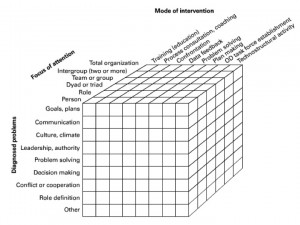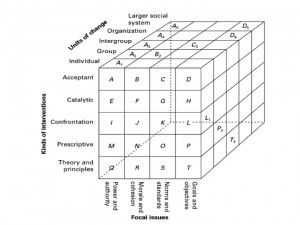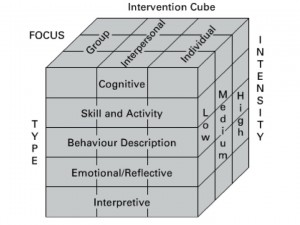Archive for June, 2012
The Three Cubes of Intervention – Organisation Development
come in a range of shapes and sizes, but what distinguishes them from other experiences of organisation change is that the interventions are planned with the purpose of improving organisational effectiveness.
“An intervention is a change effort or a change process. It implies an intentional entry into an ongoing system for the purpose of initiating or introducing change.” Rothwell
An Organisation Development Intervention therefore requires the OD practitioner to develop a structured plan within the existing organisational system. The activity may be at an individual, team, department, function or organisational level, but regardless of the size of the intervention the intervention should disrupt the status quo and develop the participants, shifting to new, improved levels of performance.
The variety of interventions available to the OD practitioner are wide ranging and as such require different skills and knowledge depending on the complexity of the intervention. Organisation Development interventions are always bespoke, never off the shelf, because they need to reflect the needs of the organisation and participants at a particular point in time. It is therefore recommended that OD practitioners build their interventions around the ‘three cubes of intervention model.’
Schmuck and Miles (1976) developed the ‘OD Cube’ to help the practitioner focus on the three interacting dimensions that should be considered in the intervention design phase;
- The Diagnosed Problem
- The Focus on Attention
- Mode of Intervention
A second cube was developed by Blake and Mouton (1985), the consulcube is considered to the be the most comprehensive overview elements of interventions included;
- Kind of Intervention
- Focal Issues
- Theories of Change
Reddy (1994) focuses on the process work completed by consultants, primarily within a team or group environment, although it can be applied more widely. The three dimensions of the Reddy Cube are;
- Focus of Intervention
- Type of Intervention
- Level of Intensity
Applying the Three Cubes
should check progress against the ‘three cubes of intervention model’ principle to ensure discipline and rigour in the intervention design in order to deliver an intervention which is built cross-dimensionally. The cube framework guides robust design whilst still allowing room for the OD practitioner to use their imagination.
Three Cubes Of Intervention Design Checklist
- What problems have been identified through the Diagnostic phase?
- What specific issues should the intervention focus on?
- What level within the organisation system is the intervention aimed at – Individual, group or organisation wide?
- What elements of the organisational system is the focus of attention upon?
- What is the role of the OD practitioner in the intervention?
- How many participants in the organisational system will be impacted?
- How much exposure will participants have to the intervention?
- What impact are you intending the intervention to have?
- What mode of intervention will you employ?
Five Core Theories – Lewin’s Change Theories – Organisation Development
There are five core theories that provide a solid foundation for the work that OD practitioners do. Good grounding in theory is essential for every OD practitioner. The better you understand the theory, the better you will understand the complex and intricate nature of the OD process and OD tool kit.
Lewin’s Change Theories in Brief
Lewin developed a unified change theory based on four distinct elements; Field Theory, Group Dynamics, Action Research and the Three step model of Change. All have been criticised and all are necessary to bring about planned change.
Lewin viewed the social environment as a dynamic field which impacted in an interactive way with human consciousness. The theories are useful to the OD practitioner in understanding that by adjusting elements of the organisationl environment then particular types of psychological experience predictably ensue. In turn, the person’s psychological state influences the organisational environment.
Lewin first introduced the idea of Group Dynamics in relation to the study of the interaction of complex intra- and inter-personal forces in the operation of group behaviour which determine the groups character, development, and long-term survival.
Lewin was well known for “field theory”. He was perhaps even better known for practical use of his theories in studying group dynamics, solving social problems related to prejudice, and group therapy (t-groups). Lewin sought to not only describe group life, but to investigate the conditions and forces which bring about change or resist change in groups.
In developing the Field Theory approach, Lewin believed that for change to take place, the total situation has to be taken into account. If only part of the situation is considered, a misrepresented picture is likely to develop.
The field theory proposes that human behaviour is the function of both the person and the environment, this means that an individuals behaviour is related both to their personal characteristics and to the organisational situation in which they find themself.
Lewin’s three step model of change is related to Field Theory. The three step model states that organisational change involves a move from one static state via a progressional shift, to another static state. The model, is also known as Unfreeze-Change-Refreeze.
Stage 1: Unfreeze
This stage involves creating the right conditions for change to occur. By resisting change, people often attach a sense of identity to their environment. In this state, alternatives, even beneficial ones, will initially cause discomfort. The challenge is to move people from this ‘frozen’ state to a ‘change ready’ or ‘unfrozen’ state.
Stage 2: Transition
The transitional ‘journey’ is central to Lewin’s model and at the psychological level it is typically a period of confusion. People are aware that the old ways are being challenged, but there is no clear understanding of the new ways which will replace them. As roles change, a reduced state of efficiency is created, where goals are significantly lowered. The end goal of this stage is to get people to the ‘unfrozen’ state and keep them there.
Stage 3: Refreeze
The end goal of the model is to achieve a ‘refreeze’, re-establishing a new place of stability and elevate comfort levels by reconnecting people back into their safe, familiar environment. Refreezing takes people from a period of low productivity in the transitional state to that of organisational effectiveness and sustainable performance.
Key Points
- Organisational Behaviour is a function of a person’s personality, the group environment
- For change to be effective it must be collaborative and participative, and take place at a group level if individual behaviour is to shift
- Concentrate on individual field factors including group norms, roles, interaction and social processes
- Refreezing requires changes at a cultural level, to embed new organisaitonal norms, polciies and practices.
- Creating dissatisfaction with the status quo will provide th disequilibrium required to drive change.
Applying Lewin’s Change Theories in an OD Intervention
- Pay attention to group dynamics and the powerful forces within the groups
- Identify existing rules that create the current organisational reality and change them to create movement.
- Plan the mix of people involved in diagnostic events in order to shift forces and facilitate change.
- Diagnostic events are key learning events which lead to ‘unfreezing’
- Be clear about the type of ‘unfreezing’ work that is needed during the diagnostic phase
- Provide a safe environment in which to destablise the status quo, in order to create the motivation to learn and change
- Support individuals and the group in understanding what is required of them, providing a plan for the action needed to begin making the change
- Create psychological safety to prevent resistance
- Provide a desirable direction or ‘best way’ for group members to change toward.
- Develop congruence with the organisation environment to stablise the new equilibrium.
Five Core Theories – Action Research Theory – Organisation Development
There are five core theories that provide a solid foundation for the work that OD practitioners do. Good grounding in theory is essential for every OD practitioner. The better you understand the theory, the better you will understand the complex and intricate nature of the OD process and OD tool kit.
Action Research Theory in Brief
Lewin developed a unified change theory based on four distinct elements; Field Theory, Group Dynamics, Action Research and the Three step model of Change. All have been criticised and all are necessary to bring about planned change.
Lewin is one of the founding fathers of Organisation Development, especially the pursuit of the commitment to humanistic values in developing society, facilitating change through learning and the pursuit of changing an individuals mental models and perceptions of the world that they inhabit in order to move forward.
Action Research is the foundation stone of Organsation Development practice, it is what underpins the theory and practice of the discipline in the organisation. The theory is based on what Lewin advised, “no action without research, no research without action.”
The theory provides the very heart of the purpose of the OD diagnostic phase in the OD cycle. It provides the opportunity to build the knowledge of the causes and dynamics of organisational issues, the understanding of organisational change and the basis of the need for collaboration and joint inquiry between the OD practitioner and the organisational players experiencing the change.
Ultimately though it is a theory based on pragmatism, data itself is no the answer to change, but data regarding the issues that the organisation is experiencing provides the catalyst for change and provides the basis for practical solutions owned by all members affected by the change. Action Research provides both the theoretical underpinnings and the practical application of organisational change.
Key Points
- Action Research is a four step continuous process; Diagnosis, Planning, Action and Evaluation
- Action Research Theory provides the bridge between knowledge building and data gathering with effective action
- It empowers employees and enables the organisation to sustain the change by providing data not only of how to make the changes required today but also on the change process itself
- Action refers to the OD interventions that are implemented to develop the organisation
- All organisational stakeholders are involved in the collaborative process of creating and executing the planned changes.
Applying Action Research Theory in an OD intervention
- Involve the people affected by the change so that they become co-investigators into the reasons for change, and participate in analysing the current reality
- Let individuals discuss the future they need to move toward
- Work to increase the amount and quality of inquiry between people so that they can learn from each other and gather a rich mix of data
- Secure a commitment to give some decision making power to the people involved in collecting the data so that real change can be achieved
- Set up a temporary diagnostic team by using those key individuals who have to support the implementation of change.
- Provide space for individuals to reflect on the insights they have gained
- Plan the direction of change/OD intervention in collaboration with all stakeholders
- Implement decisions that employees and leaders make democratically
- Provide a learning zone where individuals and groups can self organise for change.
Five Core Theories – Systems Theory – Organisation Development
There are five core theories that provide a solid foundation for the work that OD practitioners do. Good grounding in theory is essential for every OD practitioner. The better you understand the theory, the better you will understand the complex and intricate nature of the OD process and OD tool kit.
Systems Theory in Brief
Systems Theory was first introduced by Van Bertalanffy (1950) and was introduced into the organisational setting by Kataz and Khan (1966). Systems theory is an approach to organisations which likens the enterprise to an organism with interdependent parts, each with its own specific function and interrelated responsibilities. The system may be the whole organisation, a division, department or team; but whether the whole or a part, it is important for the OD practitioner to understand how the system operates, and the relationship the parts of the organisation have.
The emphasis in OD is that that real systems are open to, and interact with, their environments, and it is possible to acquire new properties through emergence, resulting in continual evolution. Rather than reducing an organisation to the properties of its parts or elements, systems theory focuses on the arrangement of and relations between the parts which connect them into a whole.
Key Points
- The organisation is an open system, which interacts with the environment and is continually adapting and improving.
- The organisation influences and is influenced by the environment in which it operates
- If an organisation is to be effective it must pay attention to the external environment, and take steps to adjust itself to accommodate the changes in order to remain relevant
- All part of the organisation are interconnected and interdependent; If one part of the system is affected, all parts are.
- It is not possible to know everything about the system, but if you look hard enough there are plenty of clues.
Applying Systems Theory in an OD Intervention
- Use mixed groups to achieve a rich understanding how the change is seen from different perspectives.
- Generate a holistic view of what must be done to give the organisation a secure future
- Use diagnostic events to enhance people’s understanding of important independencies and to support them in devising a way forward
- Help different sub-systems to work well together in independent areas
- Use processess that will increase collaboration across units
- Honour the primacy of relationship between different groups
- Where possible bring in outside bodies/data to stimulate the organisation to think about the issues
- Expose people to the outside world in which the organisation operates
- Ensure the organisation stays externally sensitive and not insulated in their perspective.
- Help the leadership team understand that they don’t have all the data required to manage change the organisation desires.






